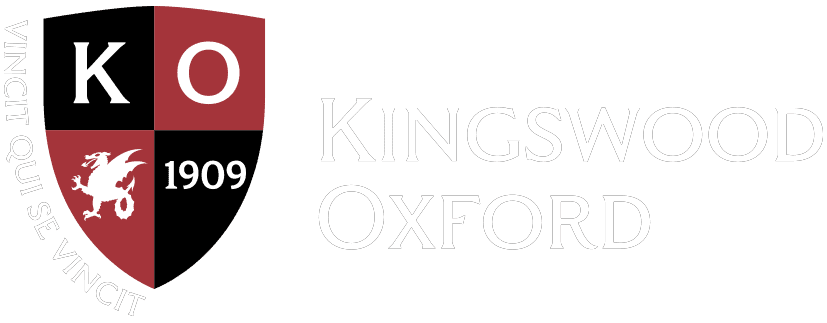May 01, 2025
Visiting Artist Mark Wood – From Juilliard to Jimi Hendrix
Through the generosity of the Goodman Banks Visiting Artist Series, KO students were treated to another enriching learning experience made possible by this series. Mark Wood, celebrated violinist, visited the campus for two days, working with the various musical groups, performing at an assembly, and at Patricia Rosoff Upper School Arts Night.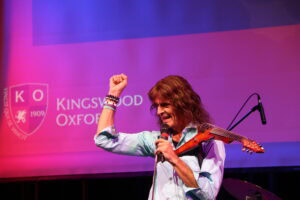
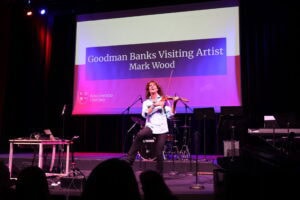
When you think of a Juilliard-trained violinist, you might imagine a tuxedoed musician in a grand concert hall, bowing in perfect form to the music of Mozart or Brahms. But Mark Wood is anything but conventional. With wild energy, shaggy hair, black jeans, custom-built electric violins, and a passion for pushing the boundaries of music, Wood is living proof that classical training and rock-and-roll spirit can coexist in powerful harmony. Wood was a key part of the popular Trans-Siberian Orchestra – an unlikely mix of hard rock and Christmas tunes.
Wood held up two violins — one traditional, and one unmistakably futuristic. “The instrument in my right hand has been around for over 400 years,” he explained. “Stradivarius lived 350 years ago… His instruments today go for millions of dollars.” He pointed out how the classical violin has hardly changed in centuries — always four strings, always the same basic shape.
But the violin in his left hand? That one was his own invention — a seven-string flying ‘V’ electric violin, custom-designed with a self-supporting body that removes the need for a chin rest. “I developed a patented system so the instrument supports itself,” he said. “I’ve got violin, viola, cello, and bass — how cool am I?”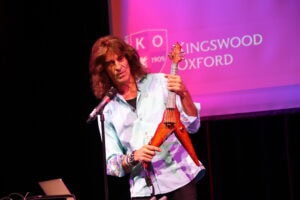
And just as the students were absorbing this marvel of musical engineering, he flipped a switch and transformed his violin into a screaming electric guitar. “I heard a guy named Eddie Van Halen,” he said with a grin. “And I thought, I’ve got to play like him.”
With his fiery compositions and performances, Wood pushed the violin to its limits. His virtuosity was on full display as he performed a mash-up of Michael Jackson’s “Smooth Criminal,” Charlie Daniels’ “The Devil Went Down to Georgia,” and Deep Purple’s “Smoke on the Water,” which set the crowd rocking. He entertained the crowd by walking among those seated as he shredded the violin and high-fived. Wood performed Steppenwolf’s “Born to be Wild” with the jazz band, an experience they won’t soon forget.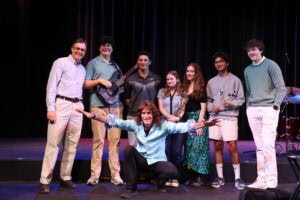
The journey that led Mark Wood to become a boundary-breaking musician began long before Juilliard — in fact, long before he was even born.
He took the audience back nearly a century, showing a black-and-white photo of his grandfather, Albert Wood, at 25. “He was Henry Ford’s first architect,” Wood shared proudly. “And he never went to school.” Instead, he taught himself everything from books at the library — a trait that ran in the family.
Wood grew up surrounded by artistry. His father, a renowned abstract expressionist painter, filled their home with changing canvases every week, and his mother was a concert pianist. Together, they raised four sons — each a string player — fulfilling her dream of having a string quartet in the family.
The Wood home, as Mark described it, was a haven of sound and color. “Can you imagine living like that?” he said. “It was heaven.”
Wood’s formal training culminated in a full scholarship to the Juilliard School, one of the most prestigious music schools in the world. There, he immersed himself in the works of Beethoven, Mozart, and Mahler. “I played classical music every day. I loved it,” he said. But his heart started to pull in a different direction — toward the sounds of Jimi Hendrix, the Beatles, and Led Zeppelin. “My training at Juilliard prevented me from being truly creative,” he said. However, Wood still practices playing classical music every day to keep his fingers nimble
That shift wasn’t exactly embraced. “So they threw me out the window at Juilliard,” he joked.
Undeterred, he returned to his family’s workshop — the very same one where his grandfather crafted furniture for the United Nations and Amelia Earhart. There, he began building electric violins by hand. One had two necks. Another glowed in the dark. One could launch bottle rockets over the audience.
“My mother freaked out when she heard I wasn’t going to be a classical musician,” he said. “She said, ‘Mark, what are you doing with your life? There’s no such thing as a rock violin player.’” His response? “I’ll figure it out.” So for the next five years, he slept on the floor in his parents’ house.
Wood didn’t just figure it out — he redefined what it means to be a violinist. Today, he’s not only a performer but also an inventor, educator, and entrepreneur. His seven-string Viper electric violin is used by musicians worldwide. And he’s on a mission to inspire the next generation.
At the Goodman Banks assembly, he encouraged students to see music not just as a tradition, but as a launchpad. He showed how classical training can be a foundation for invention, for freedom, and for finding your voice — whether you’re in a concert hall or a rock arena. He shared that even Beethoven improvised. “There’s a magic and mystery to his music,” he said. “There’s a moment of him being classically trained but also a self-taught thinker.”
Throughout his two-day visit, Wood will work with the orchestra, concert band, and Outlook. Wood will also be featured at the Patricia Rosoff Upper School Arts Night.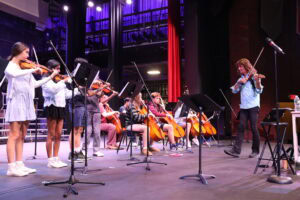
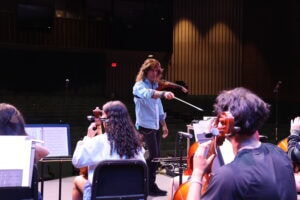
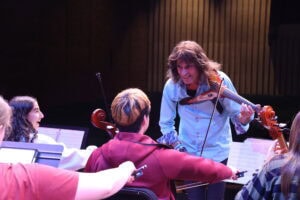
Arts
News Main News
